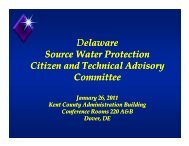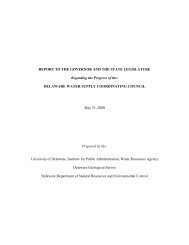Water Quality Trading in the Lower Delaware River Basin: A ...
Water Quality Trading in the Lower Delaware River Basin: A ...
Water Quality Trading in the Lower Delaware River Basin: A ...
You also want an ePaper? Increase the reach of your titles
YUMPU automatically turns print PDFs into web optimized ePapers that Google loves.
Table 3-4. Christ<strong>in</strong>a TMDL target limits for Dissolved Oxygen that are recommended by<br />
<strong>the</strong> 2004 Low Flow TMDL of <strong>the</strong> Christ<strong>in</strong>a Bas<strong>in</strong> (EPA 2004a).<br />
Parameter Target Limit Reference<br />
Daily Average DO, freshwater, 5.0 mg/l Pennsylvania <strong>Water</strong> <strong>Quality</strong><br />
Pennsylvania<br />
Standards<br />
Daily Average DO, freshwater, 5.5 mg/l <strong>Delaware</strong> <strong>Water</strong> <strong>Quality</strong><br />
<strong>Delaware</strong><br />
Standards<br />
DO at any time, Maryland 5.0 mg/l Maryland<br />
Standards<br />
<strong>Water</strong> <strong>Quality</strong><br />
M<strong>in</strong>imum DO, freshwater 4.0 mg/l Pennsylvania and <strong>Delaware</strong> <strong>Water</strong><br />
<strong>Quality</strong> Standards<br />
The Christ<strong>in</strong>a high flow TMDL is focused on sediment and bacteria from po<strong>in</strong>t<br />
and NPS, <strong>in</strong>clud<strong>in</strong>g storm water and storm sewage systems. The TMDL’s target<br />
endpo<strong>in</strong>t for bacteria was selected to ma<strong>in</strong>ta<strong>in</strong> recreational contact use dur<strong>in</strong>g both<br />
swimm<strong>in</strong>g and non-swimm<strong>in</strong>g seasons. In this analysis <strong>the</strong> ma<strong>in</strong> PS were municipal<br />
separate storm sewer systems (MS4s). With<strong>in</strong> <strong>the</strong> bas<strong>in</strong>, <strong>the</strong>re are 40 MS4-NPDES<br />
permits. Nonpo<strong>in</strong>t sources of sediment and bacteria that were considered <strong>in</strong>clude septic<br />
systems, agriculture, wildlife, and domestic pets. The sediment endpo<strong>in</strong>t was determ<strong>in</strong>ed<br />
by us<strong>in</strong>g <strong>the</strong> reference watershed method and ranges between 0.09 to 1.04 tons/acre/yr.<br />
Both <strong>the</strong> high-flow TMDL and <strong>the</strong> low-flow TMDL’s for <strong>the</strong> Christ<strong>in</strong>a <strong>Water</strong>shed<br />
used <strong>the</strong> EFDC model to simulate conditions <strong>in</strong> <strong>the</strong> waterway. However, each TMDLs<br />
used a different watershed load<strong>in</strong>g model. Inputs for <strong>the</strong> low-flow TMDL were estimated<br />
from <strong>the</strong> product of <strong>the</strong> flow rate for each subwatershed and a characteristic concentration<br />
for <strong>the</strong> particular contam<strong>in</strong>ant. These concentrations were based on a comb<strong>in</strong>ation of<br />
STORET data and field observations at monitor<strong>in</strong>g stations. The high-flow TMDL used<br />
a comb<strong>in</strong>ation of HSPF and SWMM to develop <strong>the</strong> <strong>in</strong>put loads (EPA 2005). HSPF was<br />
used to develop <strong>the</strong> loads from po<strong>in</strong>t and nonpo<strong>in</strong>t sources. SWMM was used to identify<br />
loads from comb<strong>in</strong>ed sewer overflows (CSOs) from <strong>the</strong> city of Wilm<strong>in</strong>gton. All of <strong>the</strong>se<br />
model<strong>in</strong>g efforts were based on data characterized as “extensive and high-quality”.<br />
Model calibration and validation was confirmed by EPA by show<strong>in</strong>g that <strong>the</strong> model was<br />
able to simulate <strong>the</strong> locations of <strong>the</strong> impaired stream.<br />
The allocation of TMDL based reductions<br />
The EMPR allocation strategy was used <strong>in</strong> allocat<strong>in</strong>g <strong>the</strong> reductions required <strong>in</strong> <strong>the</strong> low<br />
flow TMDL analysis. In this strategy all po<strong>in</strong>t-source dischargers are reduced by equal<br />
percentages <strong>in</strong> reiterative model runs until WQS are met. Thus <strong>the</strong> marg<strong>in</strong>al rate of<br />
removal for all affected dischargers is <strong>the</strong> same but <strong>the</strong> absolute quantity removed maybe<br />
different. In <strong>the</strong> Christ<strong>in</strong>a bas<strong>in</strong> <strong>the</strong> EMPR strategy was applied <strong>in</strong> multiple levels of<br />
analysis (EPA 2004a).<br />
57




